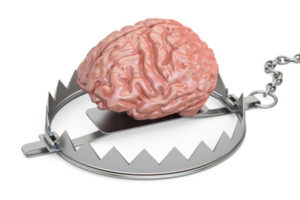Violence and the Brain

Reporting for the Las Vegas Review-Journal, Jessie Bekker said Stanford University would begin a targeted autopsy investigation on the brain of Las Vegas mass shooter Stephen Paddock. Experts have already expressed doubt that an autopsy alone will uncover clues as to why Paddock did what he did. A University of Utah neuropathologist said a pathologist could look for evidence of something like dementia or CTE—chronic traumatic encephalopathy. I wonder if they will look for a possible connection between his violence and a diminished metabolic capability with his cytochrome P450 gene family.
Yolande Lucire, a forensic psychiatrist with fifty years of experience, has been investigating this possibility for a number of years. I first heard of her and her work at a conference presentation she made in March of 2012 on “Akathisia Homicides.” You can watch a video of her 35-minute presentation at the conference here on YouTube. She’s not anti-drug, but believes a disregulation with the cytochrome P450 gene family, which produces drug-metabolizing enzymes, could be a factor in akathisia-related violence and suicide. In other words, there can be an adverse reaction to psychiatric medications when the cytochrome P450 family of enzymes fail to metabolize those psychiatric medications.
This adverse reaction could lead to akathisia, a state of “increased tenseness, restlessness and a feeling of being very uncomfortable.” There can also be irritability and/or insomnia. An estimated 20% of people on an antidepressant will have significant symptoms of akathisia and at least 50% of individuals on an antipsychotic with symptoms of akathisia. On higher doses of antipsychotics, that percentage can increase to 80% or more.
In an open access journal, Epidemiology, Dr. Lucire published an article titled “Phramacological Istrogenesis: Substance/Medication-Induced Disorders That Masquerade as Mental Illness.” She described how information on the safety and efficacy of psychiatric medications has been manipulated to favor the “pseudo-scientific ideology of the pharmaceutical industry.” Adverse side effects from the medication becomes misinterpreted to justify ongoing treatment with the very medications causing the problems; or to justify treatment of the adverse events with another medication. “There was a pill for every ill and another for each side effect.”
Misinformation has resulted in prescribing practices that produced an epidemic of akathisia-related suicide and homicide as well as substance/medication-induced conditions mimicking the mental illnesses that the drugs were supposed to cure or prevent.
Lucire said the dominant view of how to practice psychiatry has come from the pharmaceutical industry and its agents. Regulatory bodies reinforce this view when they recommend the continued use of antidepressant medications in cases where individuals only became suicidal or psychotic after taking their medication. “Their members have no comprehension of Cytochrome P450-based interactions described in product information and refuse to countenance drug company fraud.” She further observed:
A Medical Board has determined that medications and doses that had caused people to commit suicide and homicides were ‘standard psychiatric treatment’ even when the consequence had been fatal. Akathisia cases were not investigated or given any credit. Coroners sitting on five cases of antidepressant-akathisia-related suicides brought before them refused to hear this evidence.
She co-authored another article that described three cases of what authors believed were instances of antidepressant-induced akathisia-related suicide: “The relevance of cytochrome P450 polymorphism in forensic medicine and akathisia-related violence and suicide.” They also had “diminishing mutations in the CYP450 family of metabolizing enzymes and all were taking medicines that further decreased metabolism by inhibition.” None of the three knew they were supposed to take their medications regularly or how to stop taking them safely. None of them improved on the medications and none of their prescribers recognized their complaints as adverse drug reactions. See: “Psych Drugs and Violence” for more on this article. You can also explore more on Dr. Lucire’s work on her website.
Dr. Lucire’s work is not without its detractors. An earlier 2011 article she co-authored, “Antidepressant-induced akathisia-related homicides associated with diminishing mutations in metabolizing genes of the CYP450 family,” was critiqued by Loonen and Verkes in a letter to the editor of Pharmacogenomics and Personalized Medicine. They thought the population of that study was too heterogeneous and poorly characterized from a phenomenological perspective. They also suggested her use of the term “akathisia” was not defined well and could result in a false interpretation between aggression and akathisia. See a copy of their critique and Lucire’s reply here.
Yolande Lucire replied to the critique by noting how their paper pointed out how akathisia has been correlated with aggression, suicide and homicide as far back as the 1950s. In response to their curious criticism of her article not providing a definition for akathisia, she said akathisia could range in intensity from mild discomfort to “the most painful and dangerous mental state known to psychiatry.” She said the DSM-III defined akathisia as “a subjective desire to be in constant motion caused by drug sensitivity.” She also referred to the DSM-IV, which said the condition fluctuated with the subjects describing bouts of restless legs, twitching, toe turning, pacing and other activities, that occurred outside of the interview hours.
She then commented how the FDA’s restriction to indentify akathisia “only when its physical manifestations appeared in front of the interviewer” led to under diagnosis of the condition. Professor Loonen’s sense, that akathisia should be limited even further to what has been observed within a circumscribed timeframe, would result in even more cases being missed “with tragic consequences.”
Akathisia is rarely monocausal in clinical practice. It is dose related and cases formerly thought to be idiosyncratic are now known to be associated with diminished cytochrome metabolism, the co-prescription of cytochrome inhibitors, the removal of inducers, competition from polypharmacy for enzymatic substrate, diet and age of the patient, and their general and liver health.
Dr. Lucire’s work with diminished cytochrome metabolism isn’t the only voice raised in concern over a connection between antidepressants and violence or suicide. Dr. Peter Breggin has been warning of this issue since the first edition of his book, Toxic Psychiatry, in 1991. Dr. Breggin wrote of a February 7, 1991 New York Times article, “Suicidal Behavior Tied Again to Drug: Does Antidepressant Prompt Violence?” The article referred to cases of suicidal ideation that had been described in a letter in the New England Medical Journal. The individuals reportedly had not had previous signs of wanting to kill themselves. More than fifty lawsuits were filed against the manufacturer, Eli Lilly, at the time. “Other lawsuits blame Prozac for driving patients to mutilate themselves and even to commit murder.”
In the American Journal of Psychiatry, “Emergence of Intense Suicidal Preoccupation During Fluoxetine Treatment” reported how six depressed patients, “free of recent suicidal ideation, developed intense, violent suicidal preccupation after 2-7 weeks of fluoxetine treatment.” This persisted for a range of 3 days to three months after fluoxetine treatment was discontinued. Breggin added:
The report estimates that 3.5 percent of Prozac users were at risk. While denying the validity of the study, Dist Products, a division of Eli Lilly, put out a brochure for doctors dated August 31, 1990, stating that it was adding “suicidal ideation” to the adverse events section of its Prozac product information.
So what happened? According to David Healy in “Vampire Medicines,” the Teicher et al. article (“Emergence of Intense Suicidal Preoocupation During Fluoxetine Treatment”) offered undeniable evidence that SSRIs can cause suicide and hearing were convened to discuss the need for warnings. “But coincident with these hearings, BMJ [British Medical Journal] published a meta-analysis of Prozac trials which Lilly claimed showed Prozac was not linked to suicidal events.”
The published data showed an increased risk on Prozac, which Lilly and BMJ ignored, claiming nothing was statistically significant. Beyond this, Lilly played some of the tricks other companies later played – the small print shows the only placebo event hadn’t happened on placebo, so that technically there was a statistically significant infinitely greater risk on Prozac.The way this played in public was that the stories of suicides on Prozac were tragic but anecdotal. The scientific evidence demonstrated that patients and doctors just can’t believe the evidence of their own eyes and ears. They have to be told what’s what by experts.This dangerous and misguided message triumphed with regulators, and later in Courts.This message killed any interest journals like AJP and BMJ had in taking Case Reports. Besides companies didn’t buy reprints of these, whereas they handed over huge amounts of money for reprints of ghost-written fraudulent RCTs with zero access to data, and even more for the best science money could buy – meta-analyses of these trials. Evidence Based Marketing was here.
So what happens when there is a mass shooting like that in Las Vegas with Stephen Paddock, or with Devan Patrick Kelley in Sutherland Springs Texas? The possible connection between gun violence and psychiatric medications like antidepressants in the media is voiced by individuals like Kristie Alley (see here) and Pat Robertson (see here) who can be dismissed or marginalized by readers and viewers for their religious stands on Scientology and evangelical Christianity respectively. Additionally, they have no personal scientific or medical credibility. Individuals like Yolande Lucire, Peter Breggin or David Healy who do have medical and/or scientific credibility are not the go-to “talking heads” in main stream media outlets on the possible connection between psychiatric medications and violence, especially gun violence.
It’s not too late to prevent the trap on unsuspecting brains from being sprung. Yolande Lucire’s research findings and the critiques of Peter Breggin and David Healy should not be dismissed as fringe science. There have been reports of akathisia associated with aggression, violence and suicide from the 1950s. Peter Breggin was pointing out a similar connection from the honeymoon time with the first SSRI, Prozac. David Healy has been pointing out the connection between antidepressants and violence for years (See this link to a search on his website for “antidepressants violence”).
Not every instance of gun violence or mass shooting can be attributed to diminished cytochrome metabolism or akathisia-induced violence. But when the total number of incidents of gun violence in the US from January 1 to December 1 of 2017 was 56,355, and the number of mass shootings for the same time period was 324, there is a good chance an investigation would confirm an association in many of them. Below is a graphic taken from the website Gun Violence Archive that shows the geographic distribution of the 324 incidents of mass shooting. Also see: “Iatrogenic Gun Violence” on this website.
Post Script. The number of incidents of reported gun violence in the U.S. on Gun Violence Archive rose from 56,355 on December 1st, 2017 to 61,418 on December 31st, 2017. The number of mass shootings increased to 345. The 2018 totals were 2,628 incidents of gun violence and 12 mass shootings on January 20th, 2018. Go see where the totals are when you read this.


